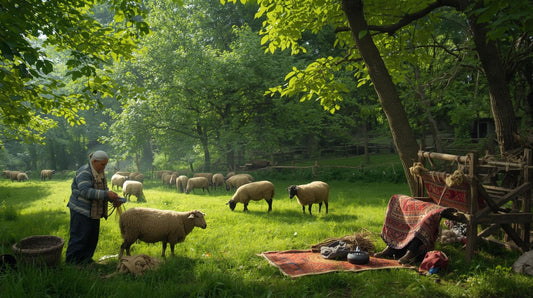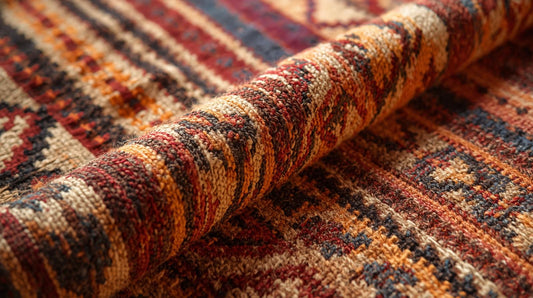The Timeless Art of Natural Dyes in Turkish Carpets: A Deep Dive

Turkish carpets, renowned for their intricate patterns and vibrant hues, have captivated the world for centuries. At the heart of their allure lies the use of natural dyes, derived from plants, insects, and minerals, which imbue these textiles with depth, subtlety, and a connection to the earth. This article explores the history, sources, techniques, and enduring appeal of natural dyes in Turkish carpet weaving, drawing on traditional practices that have been passed down through generations. Whether you're a collector, designer, or simply an admirer of cultural heritage, understanding these dyes reveals the artistry behind every knot.

A Brief History of Natural Dyes in Turkish Carpets
The tradition of dyeing textiles with natural materials dates back thousands of years, with evidence of plant-based dyes appearing in ancient civilizations across the Mediterranean, Middle East, and Asia. In Turkey, this practice flourished under the Ottoman Empire, where trade routes facilitated the exchange of dyestuffs like madder and indigo from regions such as Persia, India, and Europe. Nomadic tribes and village weavers relied on locally available resources, elevating dyeing to an art form intertwined with cultural and even spiritual significance—dyers were often revered as guardians of secret rituals.
Before the mid-19th century, all Turkish carpets were colored exclusively with natural dyes, producing colors that were not only vibrant but also harmonious due to their organic origins. The introduction of synthetic dyes in the 1850s, such as aniline and later chrome-based ones, revolutionized production by offering uniformity and lower costs. However, early synthetics were unstable, prone to fading and bleeding, leading to a decline in quality. In recent decades, there's been a revival of natural dyes in Turkey, driven by a desire for authenticity, sustainability, and the unique aesthetic they provide—subtle variations known as "abrash" that give carpets character and depth.
Sources of Natural Dyes: From Nature to Yarn
Natural dyes in Turkish carpets come from three primary categories: plants (the most common), insects, and occasionally minerals. These sources are harvested locally or traded, reflecting Turkey's rich biodiversity and historical trade networks. A comprehensive study identified 123 plant species from 50 families used in Turkish dyeing, predominantly in regions like Anatolia where carpet weaving thrives.
### Plant-Based Dyes
Plants provide the backbone of Turkish carpet colors, with various parts—roots, leaves, bark, flowers, or fruits—extracted for pigments. Key examples include:
- **Madder (Rubia tinctorum)**: Roots yield shades of red, orange, and purple. Known as "Turkish red," it's been used for over 5,000 years and is central to Anatolian carpets.
- **Indigo (Indigofera tinctoria)**: Leaves produce deep blues through fermentation. Native to India but widely adopted in Turkey via trade.
- **Weld (Reseda luteola)**: The aboveground plant gives bright yellows, highly light-fast and wash-fast, making it a staple in Turkish weaving.
- **Pomegranate (Punica granatum)**: Rinds offer yellows and greens, native to Persia but common in Turkish dyes.
- **Walnut (Juglans regia)**: Husks and bark provide browns, widely available in the Middle East.
- **Saffron (Crocus sativus)**: Flowers yield golden yellows, valued for its rarity and dual use in cuisine.
- **Other notables**: Onion skins for yellows, sumac for browns, turmeric for bright yellows, and oak bark for tans and browns.
These plants are often native or cultivated in Turkey, with yellow being the most common color (from 84 species), followed by green (41) and brown (33).
### Insect-Based Dyes
Insects add vivid reds and purples:
- **Cochineal (Dactylopius coccus)**: From insect shells, produces burgundy reds. Introduced from Mexico via Ottoman trade.
- **Lac**: From beetle shells, for reds or violets.
### Mineral and Other Sources
Minerals like iron salts are used for blacks or to modify colors, often as mordants rather than primary dyes.
## Common Colors and Their Dye Combinations
Turkish weavers masterfully combine dyes to achieve a spectrum of shades. Here's a breakdown:
| Color | Primary Dyes | Sources | Notes |
|-------|--------------|---------|-------|
| Red | Madder, Cochineal, Safflower | Plant roots, insect shells, flowers | Madder for orange-red; cochineal for burgundy. |
| Blue | Indigo | Plant leaves | Fermented for royal blues. |
| Yellow | Weld, Saffron, Pomegranate, Turmeric | Plants, fruits | Weld is highly stable; saffron for luxury shades. |
| Green | Indigo + Yellow dyes (e.g., Weld) | Overdyeing | Rare and costly due to fading issues. |
| Brown | Walnut, Oak bark, Sumac | Nuts, bark | Often from undyed wool or natural tannins. |
| Black | Iron salts + Overdyeing | Minerals + dyes | Can oxidize wool if overused. |
| Orange | Henna, Madder + Yellow | Leaves, overdyeing | Achieved through combinations. |
| Purple | Hollyhocks or Murex snails | Plants or shells | Murex for stable, expensive purples. |
Overdyeing—applying one color over another—is a hallmark technique, such as madder red with saffron yellow for orange.
Extraction and Dyeing Techniques
The process begins with harvesting and preparing dyestuffs: roots are dug up, leaves fermented, or husks boiled to extract pigments. Wool yarn is then soaked in dye baths, often for weeks, to ensure even absorption. Mordants—metallic salts like alum, iron, copper, or tin—are crucial for fixing colors, preventing fading, and altering shades (e.g., iron darkens to grays or blacks). Natural mordants include tannins from oak or urine, adding to the eco-friendly appeal.
Variables like water quality, temperature, and soaking time influence the final hue, leading to the cherished abrash effect. This hands-on method contrasts with synthetic dyeing's precision but yields warmer, more luminous results.
## Benefits, Challenges, and Modern Revival
Natural dyes offer superior fade resistance—centuries-old carpets remain vibrant—along with environmental sustainability and a natural sheen that synthetics can't replicate. They create harmonious palettes because primary colors share reflective properties, enhancing overall design. Challenges include variability, higher costs, and the labor-intensive process, which limited palettes in rural areas.
Today, initiatives in Turkey revive these traditions, blending them with modern weaving for eco-conscious consumers. Projects emphasize high-quality, fade-resistant dyes for premium carpets, preserving cultural heritage while meeting global demand.
In conclusion, natural dyes are more than pigments—they embody Turkey's history, ingenuity, and bond with nature. Next time you admire a Turkish carpet, consider the roots, leaves, and insects that brought its colors to life, a testament to timeless craftsmanship. If you're incorporating this into your decor or collection, seek out pieces certified for natural dyes to experience their authentic beauty.
No comments






0 comments